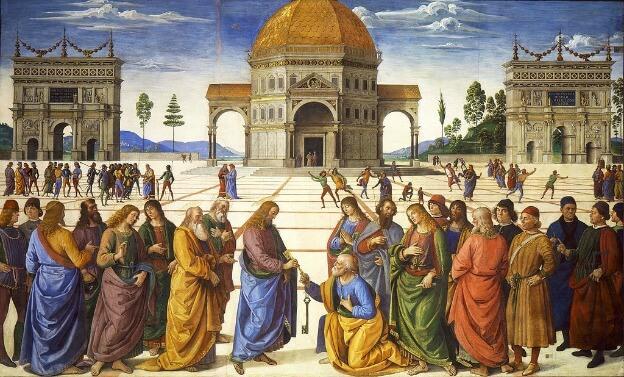Il Perugino: The Artist from Umbria Who Set the Stage for the Renaissance
ITA:

Before Raphael, there was Perugino. Born Pietro Vannucci in Città della Pieve, Perugino is Umbria’s most renowned artist, the painter behind Delivery of the Keys, a fresco commissioned by Pope Sixtus IV for the Sistine Chapel.
A contemporary of Leonardo da Vinci, Domenico Ghirlandaio, Lorenzo di Credi, and Filippino Lippi, with whom he apprenticed in Florence in the workshop of Andrea del Verrocchio, Perugino was one of the key figures of the High Renaissance, the founder of Early Classicism, and, for a couple of decades, the most famous and influential painter in Italy.
Nicknamed ‘il Perugino’, the man from Perugia, because he lived and worked extensively in the Umbrian capital, Perugino led two very active workshops in Florence and Perugia, teaching and working for such patrons of the art as Lorenzo il Magnifico. Raphael, who along with Michelangelo and Leonardo da Vinci, traditionally forms the trinity of great masters of the High Renaissance, was one of his pupils; in fact, the influence of Perugino on Raphael's early work is very clear, so much so that art historian Vasari wrote that it was impossible to distinguish between their hands during the early stages of Raphael’s career, when he worked as an assistant to Perugino.
Yet, despite all that he achieved during his long career (he worked until his death at 73 years old), Perugino isn’t a household name like Michelangelo, Raphael or Leonardo.
If you want to get better acquainted with this pivotal artist from Umbria, head to central Italy, where many of his works can be found: in Perugia, don’t miss the Galleria Nazionale dell’Umbria; then of course, his hometown of Città della Pieve houses several of his paintings, as do many smaller towns in Umbria, such as Montefalco, Spello, Panicale, Foligno and Assisi. In Florence, his Pietà and Deposition, as well as a couple of other paintings are housed in the Uffizi; and in Rome, besides the aforementioned Delivery of the Keys in the Sistine Chapel, you can admire his work in the Raphael Rooms and the Vatican Museums.
Prima di Raffaello, ci fu Perugino. Nato a Città della Pieve con il nome di Pietro Vannucci, il Perugino è l’artista umbro più famoso, il pittore di Consegna delle chiavi, un affresco commissionato da Papa Sisto IV per la Cappella Sistina.
Un contemporaneo di Leonardo da Vinci, Domenico Ghirlandaio, Lorenzo di Credi e Filippino Lippi, con i quali fece l’apprendistato a Firenze presso la bottega di Andrea del Verrocchio, Perugino fu una delle figure chiave del Rinascimento, il fondatore del primo classicismo, e, per un paio di decenni, il più famoso e influente pittore in Italia.
Soprannominato 'il Perugino', l'uomo di Perugia, perché visse e lavorò a lungo nel capoluogo umbro, Perugino aveva due botteghe molto attive a Firenze e Perugia, dove insegnava e lavorava per mecenati dell'arte del calibro di Lorenzo il Magnifico. Raffaello, che insieme a Michelangelo e Leonardo da Vinci costituisce tradizionalmente la trinità dei grandi maestri del Rinascimento, fu uno dei suoi allievi; infatti, l'influenza del Perugino sui primi lavori di Raffaello è evidente, tanto che il Vasari scrisse che era impossibile distinguere di chi fosse la mano durante le prime fasi della carriera di Raffaello, quando lavorava come assistente di Perugino.
Eppure, nonostante tutto quello che realizzò nel corso della sua lunga carriera (lavorò fino alla morte avvenuta a 73 anni), il nome di Perugino non è conosciuto come quello di Michelangelo, Raffaello e Leonardo.
Se si desidera conoscere meglio questo cruciale artista umbro, bisogna dirigersi verso il centro Italia, dove si trovano molte delle sue opere: a Perugia, da non perdere la Galleria Nazionale dell'Umbria; poi, naturalmente, la sua città natale, Città della Pieve, ospita molti dei suoi dipinti, così come molti centri minori dell'Umbria, quali Montefalco, Spello, Panicale, Foligno e Assisi. A Firenze, la Pietà e la Deposizione, e un paio di altri dipinti, sono custoditi agli Uffizi; e a Roma, oltre alla già citata Consegna delle Chiavi nella Cappella Sistina, si possono ammirare le sue opere nelle Stanze di Raffaello e nei Musei Vaticani.











